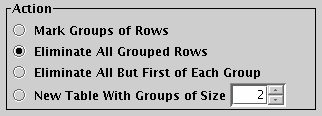
Internal Match Action Box

Internal Match Action Box
The Internal Match Action box gives a list of options for what will happen when an internal match calculation has completed. In each case a new table will be created as a result of the match. The options for what it will look like are these:
You can use this information in other ways, for instance if you
create a new Row Subset using the expression
"GroupSize == 5" you could select only those
rows which form part of 5-object clusters.